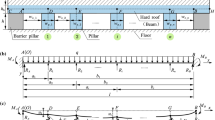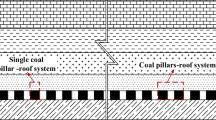Abstract
Pillar burst depends not only on the pillar itself but also on other components of the roof-pillar system. Instability theory is applied to optimize the critical condition of pillar instability, thus minimizing the likelihood of a pillar burst event. The instability mechanism and evolution process of a pillar burst for a rock beam embedded in an elastic foundation (EF) are investigated. The unmined orebody (UMO) is considered to be an EF; the pillar’s strain-softening behavior is described by a Weibull distribution. Pillar burst events occur in the post-peak strain-softening stage of the pillar and are mainly dependent on the pillar strength and stiffness ratio rK of the UMO-roof-pillar system. The EF coefficient kf reflecting the UMO property is an important factor affecting rK. The maximum deviation of rK reaches up to 198% when the UMO is regarded as a rigid foundation (RF), which emphasizes the importance of kf in terms of overall system instability. A typical case of partial pillar recovery is simulated to demonstrate that EF hypothesis accurately reflects the UMO response in such a system. The instability conditions obtained by simulation analysis are consistent with the theoretical results. The instability of the UMO-roof-pillar system is the result of many factors, among which the thickness hb and span l of the rock beam are extremely sensitive. The lateral pressure coefficient does not significantly affect pillar instability and can be neglected to some extent. The pillar burst evolution process can be divided into a stability stage, subcritical instability stage, instability stage, and post-instability stage.












Similar content being viewed by others
Abbreviations
- EF:
-
Elastic foundation
- RF:
-
Rigid foundation
- UMO:
-
Unmined orebody
- k f :
-
Elastic foundation coefficient
- E b, I :
-
Young’s modulus and inertia moment of beam, respectively
- w o :
-
Width of open stope (or room)
- w p, h :
-
Width and height of pillar, respectively
- h b, l :
-
Thickness and span of rock beam (or hard roof), l = wo + wp/2
- q :
-
Uniform load acting on beam
- λ:
-
Lateral pressure coefficient
- P :
-
Horizontal force acting on roof, P = λqhb
- F :
-
Force of roof acting on pillar
- R :
-
Pillar supporting force against roof
- M A, R A :
-
Bending moment and shear force of beam at point A, respectively
- E :
-
Young’s modulus of pillar
- k :
-
Initial stiffness of pillar
- A :
-
Cross-sectional area of pillar
- σ,ε :
-
Stress and strain
- ε 0 :
-
Average strain
- m :
-
Shape parameter of pillar
- u :
-
Deformation of pillar
- u 0 :
-
Deformation value corresponding to pillar peak strength when m = 1
- u t = 2u 0 :
-
Deformation value at inflection point of F–u curve.
- y 1, y 2 :
-
Deflections of beam when x < 0 and 0 < x < l respectively (Fig. 1b)
- C 1 ~C 6 :
-
Undetermined coefficients defined in Eq. (5)
- α, β, γ :
-
Parameters defined as Eq. (6)
- K, b :
-
Parameters defined in Eq. (11), K is local stiffness of beam midpoint
- u j, u s :
-
Starting point and ending point of sudden jump (instability)
- \( {u}_s^{\prime } \) :
-
Previously reported ending point of sudden jump
- W st :
-
Elastic strain energy stored in pre-peak range of the pillar
- W sf1 :
-
Pillar dissipated energy between peak point and instability starting point
- W sf2 :
-
Dissipated energy during pillar instability process
- W cf :
-
Rockburst energy index
- ΔW :
-
External work acting on pillar during pillar instability process
- ΔE :
-
Excess energy not completely dissipated during pillar instability process
- K C :
-
Post-peak stiffness of pillar
- r K :
-
Stiffness ratio of system defined as Eq. (12)
- PFS:
-
Panel factor of stability, PFS = rK
- FOS:
-
Factor of safety
References
Adhikary DP, Shen B, Fama MED (2002) A study of highwall mining panel stability. Int J Rock Mech Min Sci 39:643–659
Afraei S, Shahriar K, Madani SH (2018) Statistical assessment of rock burst potential and contributions of considered predictor variables in the task. Tunn Undergr Space Tech 72:250–271
Bian ZF, Inyang HI, Daniels JL, Frank O, Sue S (2010) Environmental issues from coal mining and their solutions. Mining Sci Technol 20:215–223
Brady BHG, Brown ET (1993) Rock mechanics for underground mining. Kluwer Acadmic Publishers, London
Cook NGW (1965) A note on rockbursts considered as a problem of stability. J South Afr Inst Min Metall 65:437–446
Cook NGW, Hoek E, Pretorius JPG, Ortlepp WD, Salamon MDG (1966) Rock mechanics applied to the study of rockbursts. J South Afr Inst Min Metall 66:435–528
Deng J, Gu DS (2018) Buckling mechanism of pillar rockbursts in underground hard rock mining. Geomechanics and Geoengineering:1–16
Hauquin T, Gunzburger Y, Deck O (2018) Predicting pillar burst by an explicit modelling of kinetic energy. Int J Rock Mech Min Sci 107:159–171
He H, Dou LM, Fan J, Du TT, Sun XL (2012) Deep-hole directional fracturing of thick hard roof for rockburst prevention. Tunn Undergr Space Tech 32:34–43
Hetényi M (1950) A general solution for the bending of beams on an elastic foundation of arbitrary continuity. J Appl Phys 21:55–58
Hoek E, Kaiser PK, Bawden WF (2000) Support of underground excavations in hard rock, London
Horvath JS (1983) Modulus of subgrade reaction: new perspective. J Geotech Eng 109:1591–1596
Jaiswal A, Shrivastva BK (2012) Stability analysis of the proposed hybrid method of partial extraction for underground coal mining. Int J Rock Mech Min Sci 52:103–111
Jeremic ML (1985) Strata mechanics in coal mining. A.A Balkema, Rotterdam
Jiang QA, Feng XT, Xiang TB, Su GS (2010) Rockburst characteristics and numerical simulation based on a new energy index: a case study of a tunnel at 2,500 m depth. Bull Eng Geol Environ 69:381–388
Jiang HJ, Cao SG, Zhang Y, Wang C (2016) Analytical solutions of hard roof’s bending moment, deflection and energy under the front abutment pressure before periodic weighting. Int J Min Sci Technol 26:175–181
Krajcinovic D, Silva MAG (1982) Statistical aspects of the continuous damage theory. Int J Solids Struct 18:551–562
Lee J, Jeong S (2016) Experimental study of estimating the subgrade reaction modulus on jointed rock foundations. Rock Mech Rock Eng 49:2055–2064
Li XB, Weng L (2016) Numerical investigation on fracturing behaviors of deep-buried opening under dynamic disturbance. Tunn Undergr Space Tech 54:61–72
Li WF, Bai JB, Peng S, Wang XY, Xu Y (2015) Numerical modeling for yield pillar design: a case study. Rock Mech Rock Eng 48:305–318
Linkov A (1996) Rockbursts and the instability of rock masses. Int J Rock Mech Min Sci & Geomech Abstr 33:727–732
Lippmann H (1987) Mechanics of “bumps” in coal mines: a discussion of violent deformations in the sides of roadways in coal seams. Appl Mech Rev 40:1033
Lu CP, Liu GJ, Liu Y, Zhang N, Xue JH, Zhang L (2015) Microseismic multi-parameter characteristics of rockburst hazard induced by hard roof fall and high stress concentration. Int J Rock Mech Min Sci 76:18–32
Manouchehrian A, Cai M (2016) Simulation of unstable rock failure under unloading conditions. Can Geotech J 53:150617143612000
Mortazavi A, Hassani FP, Shabani M (2009) A numerical investigation of rock pillar failure mechanism in underground openings. Comput Geotech 36:691–697
Ortlepp WD (2005) RaSiM comes of age-a review of the contribution to the understanding and control of mine rockbursts. In: Ortlepp WD (ed) Proceedings of the Sixth International Symposium on Rockburst and Seismicity in Mines (RaSiM6). The University of Western Australia: Australian Centre For Geomechanics, Crawley, pp 3–20
Pan YS, Li ZH (2005) Analysis of rock structure stability in coal mines. Int J Numer Anal Methods Geomech 29:1045–1063
Pan Y, Li AW, Qi YS (2009) Fold catastrophe model of dynamic pillar failure in asymmetric mining. Mining Sci Technol 19:49–57
Pan Y, Gu S, Qi Y (2012) Analytic solution of tight roof's bending moment and deflection under swelling distributive supporting pressure. Chin J Rock Mech Eng 31:2053–2063
Petukhov I, Linkov A (1979) The theory of post-failure deformations and the problem of stability in rock mechanics. Int J Rock Mech Min Sci & Geomech Abstr 16:57–76
Qian MG, Miao XX, Xu JL (1996) Theoretical study of key stratum in ground control. J China Coal Soc 14:225–230
Qin SQ, Jiao JJ, Tang CA, Li ZG (2006) Instability leading to coal bumps and nonlinear evolutionary mechanisms for a coal-pillar-and-roof system. Int J Solids Struct 43:7407–7423
Salamon M (1970) Stability, instability and design of pillar workings. Int J Rock Mech Min Sci & Geomech Abstr 7:613–631
Singh R, Mandal PK, Singh AK, Kumar R, Sinha A (2011) Coal pillar extraction at deep cover: with special reference to Indian coalfields. Int J Coal Geol 86:276–288
Tajdus A, Cieslik J, Tajdus K (2014) Rockburst hazard assessment in bedded rock mass: laboratory tests of rock samples and numerical calculations. Arch Min Sci 59:591–608
Tang CA (1993) Catastrophe in rock unstable failure. China Coal Industry Publishing House, Beijing
Tang CA, Wang J, Zhang J (2010) Preliminary engineering application of microseismic monitoring technique to rockburst prediction in tunneling of Jinping II project. J Rock Mech Geotech Eng 2:193–208
Wang SY, Lam KC, Au SK, Tang CA, Zhu WC, Yang TH (2006) Analytical and numerical study on the pillar rockbursts mechanism. Rock Mech Rock Eng 39:445–467
Wang ZQ, Zhang LX, Guo HB (2011) Catastrophe theory analysis on asymmetric mining pillar dynamic failure. Appl Mech Mater 71-78:4662–4667
Wang SL, Hao SP, Chen Y, Bai JB, Wang XY, Xu Y (2016) Numerical investigation of coal pillar failure under simultaneous static and dynamic loading. Int J Rock Mech Min Sci 84:59–68
Whyatt JK, Blake W, Williams TJ (2002) White BG 60 years of rockbursting in the Coeur D’Alene district of northern Idaho, USA: lessons learned and remaining issues. In: Whyatt JK, Blake W, Williams TJ, White BG (eds) Proceedings of the 109th Annual Exhibit and Meeting. Society for Mining, Metallurgy, and Exploration, Phoenix, pp 1–10
Yu Y, Deng KZ, Luo Y, Chen SE, Zhuang HF (2018) An improved method for long-term stability evaluation of strip mining and pillar design. Int J Rock Mech Min Sci 107:25–30
Zhang MT (1987) Instability theory and mathematical model for coal/rock bursts. Chin J Rock Mech Eng 6:197–204
Zhang ZZ, Bai JB, Chen Y, Yan S (2015) An innovative approach for gob-side entry retaining in highly gassy fully-mechanized longwall top-coal caving. Int J Rock Mech Min Sci 80:1–11
Zhou J, Li XB, Mitri HS (2018) Evaluation method of rockburst: state-of-the-art literature review. Tunn Undergr Space Tech 81:632–659
Funding
This study was supported by China Postdoctoral Science Foundation (No. 2018M641706), National Science Foundation of China (No. 51904057), Fundamental Research Funds for Central Universities of China (No.170104026), and Zhejiang Collaborative Innovation Center for Prevention and Control of Mountain Geological Hazards (No. PCMGH-2017-Y-04).
Author information
Authors and Affiliations
Corresponding author
Ethics declarations
Conflict of interest
The authors declare that they have no conflicts of interest.
Rights and permissions
About this article
Cite this article
Wang, X., Guan, K., Liu, J. et al. Instability and pillar burst mechanism in roof-pillar system with rock beam embedded in elastic foundation. Bull Eng Geol Environ 80, 2447–2459 (2021). https://doi.org/10.1007/s10064-020-01991-9
Received:
Accepted:
Published:
Issue Date:
DOI: https://doi.org/10.1007/s10064-020-01991-9




